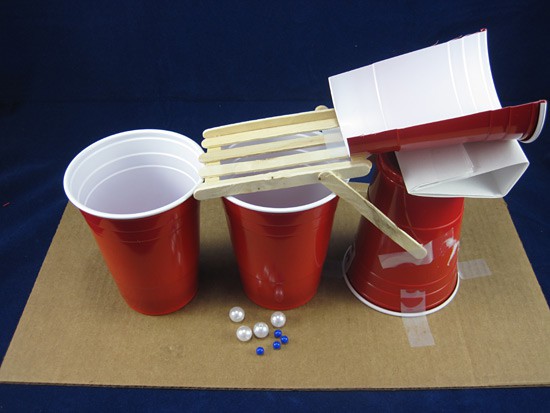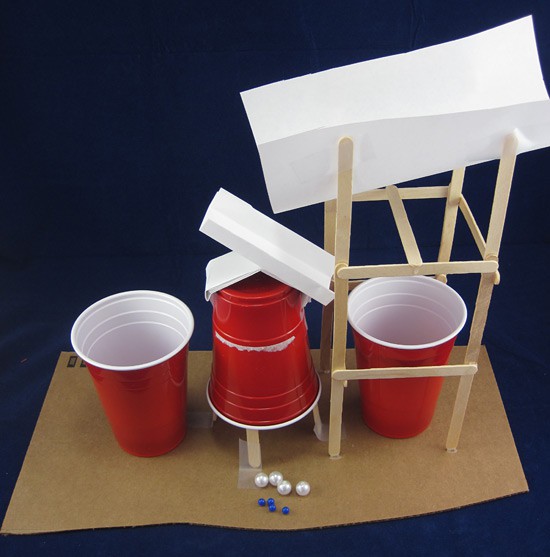Abstract
Put your engineering skills to the test to see if you can build a machine—powered by nothing but gravity—that will automatically sort out two different sizes of plastic spheres. That might seem like a strange task, but have you ever used a coin sorter to separate pennies, nickels, dimes, and quarters? How about using a sifter in the kitchen to separate fine grains of flour or sugar from bigger lumps? Machines that can automatically sort objects or particles of different sizes are used in many applications; for example, in the mining industry to separate valuable gems and minerals from rocks and dirt. Looking for inspiration? You can see how other students have tackled this and other annual Science Buddies Engineering Challenges.Summary
This engineering challenge is based on an internal competition designed by employees at Fluor Corporation.
- Scotch® is a registered trademark of 3M.

Objective
Build a gravity-powered sorting machine that can separate small and large plastic spheres.Introduction
Sorting machines come in all shapes and sizes, ranging from tiny toy coin sorters to huge industrial sifting machines used in food processing or mining. Regardless of what exactly they sort, they all have something in common: they automate a task that would be very difficult, or even impossible, for humans to do! It is not such a big deal to sort a few dollars' worth of change or to use a hand sifter for a cup of flour. What if you worked at a bank and had to sort thousands of coins, or at a food processing factory dealing with thousands of pounds of flour? Then it would certainly help to have a machine do the work.
The same is true in the mining industry. Early miners would use a manual process, called panning to separate gold nuggets from dirt and sand in a pan. Modern industrial mines use a variety of automated processes to separate valuable gems and minerals from dirt and other rocks. Some sorting systems use complex electrical sensors, for example, to measure whether a metal is magnetic or how reflective it is, in order to sort them. Others use mechanical methods like screening, where particles fall through screens with different-sized holes. Particles with a smaller diameter fall down through the screens, while larger particles stay on top. Some systems use bursts of compressed air to blow away lighter materials, while materials with a higher density remain in place. Many times, these mechanical sorters are powered by motors, but simple systems are powered only by gravity.
In this project, your goal is to build a gravity-powered marble sorting machine that can sort large and small plastic spheres (representing rocks and gems, respectively), like the ones shown in Figures 1 and 2. You will start out with a cup containing a mix of two different size spheres, pour them into the machine, and the machine should sort them into two separate cups. Keep in mind that the machines in Figures 1 and 2 are just two examples of how you could approach the task. They are not necessarily the "best" methods, and you might come up with your own design that is more creative or works better. In order to enter your design in the 2016 Engineering Challenge, you must pick from a limited list of materials to build your machine, follow a set of rules (outlined in the Procedure), and calculate a score for your machine. Continue on to the Materials section to gather the items you will need for this project.

Figure 1. An example of a gravity-powered marble machine. This machine is designed to separate spheres by diameter. Spheres are poured into the funnel at the top and then roll down the popsicle sticks. The smaller spheres fall through the gap between the popsicle sticks into the first cup, and the larger spheres continue rolling to the second cup. The video in the Procedure shows how the machine works.
 Image Credit: Ben Finio, Science Buddies / Science Buddies
Image Credit: Ben Finio, Science Buddies / Science BuddiesA marble sorting machine uses gravity to separate marbles of different weights. Scaffolding made from popsicle sticks holds a piece of paper that will funnel materials onto a hinged ramp. On either side of the hinged ramp there is a plastic cup. When a heavy marble strikes the ramp it will rotate on the hinge and deposit the marble into a cup on one end. When a lighter marble strikes the ramp the ramp will not rotate and the marble will fall into a cup on the other end.
Figure 2. Another example of a gravity-powered marble machine. This machine uses a lever to separate larger, heavier spheres from smaller, lighter spheres. The spheres are poured into a funnel, and land on a lever when they fall out the bottom. The smaller, lighter spheres are not heavy enough to tilt the lever, so they roll to the right. The larger, heavier spheres weigh enough to tilt the lever, so they roll to the left. The video in the Procedure shows how the machine works.
Terms and Concepts
- Panning
- Screening
- Diameter
- Density
- Gravity
Additional concepts that can be related to the activity:
- Gravitational potential energy
- Kinetic energy
- Energy conversion
- Simple machines
Questions
- What are some examples of sorting, screening, or sifting objects or materials from your everyday life?
- What are some large-scale or industrial examples of sorting, sifting, or screening?
- Search the internet for videos of different sorting machines. How do they work?
Bibliography
Here are some resources that can help you learn more about separating particles of different sizes:
- Wikipedia Contributors. (2015, September 2). Mechanical screening. Retrieved November 3, 2015.
- Njenga, H. (n.d.). Separation of Solids from other Solids. Retrieved November 3, 2015.
Here are two videos that show homemade coin sorters. Although they sort coins and not plastic spheres, you may be able to apply some of the same principles to your sphere-sorting machine.
- American Hacker. (2015, September 30). DIY Money Separator—(coin sorter). Retrieved November 3, 2015.
- Dunbar, J. (2015, June 11). Gravity-Powered Coin Sorter. Retrieved November 3, 2015.
Materials and Equipment
You are free to use any materials you would like for this project. However, If you want to compare your results to those of other students who did the 2016 Engineering Challenge, you can only use the materials listed below. Each item has a maximum quantity allowed per team (teams can be a single individual or multiple people), and a point cost that will be deducted from your final score (see the Procedure for details). Note that the cardboard base, tape and glue are "free" materials with no point cost.
| Material | Maximum Quantity | Point Cost (each) |
|---|---|---|
| 16 oz paper or plastic cups | 10 | 150 |
| Popsicle sticks (approx. 4.5 inch or 11.5 cm) | 50 | 30 |
| 8.5x11 inch sheets of printer paper | 20 | 75 |
| Piece of corrugated cardboard to use as a base, up to 2 ft by 2 ft | 1 | 0 |
| Roll of Scotch® tape | 1 | 0 |
| Bottle of craft glue | 1 | 0 |
In addition to the building materials, you will also need the following materials to test your machine.
| Material | Quantity | Note |
|---|---|---|
| 16 oz plastic cups | 3 | 1 to hold the initial mix of spheres, 2 to collect the sorted spheres. These do not count toward the total of 10 cups allowed to build your machine, but they must be easily removable and cannot be a structural part of your machine. |
| 6 mm plastic spheres | 25 | These represent the "gems" in your mining operation. |
| 12 mm plastic spheres | 25 | These represent the "rocks" in your mining operation. |
| Stopwatch | 1 | Used for timing the test run. |
Notes about the materials:
- The popsicle sticks should be "regular" size (not "jumbo"), approximately 4.5 inches long.
- The exact color or material of the cups does not matter. You do not have to use red plastic cups like the ones in Figures 1 and 2. Other colors and paper cups are also acceptable.
- You can use scissors or a craft knife to cut the materials, but you are still charged the full point value for an item even if you only use half of it. For example, if you cut a piece of paper in half and only use one half in your machine, you will still have 75 points subtracted from your score.
- The plastic spheres are also available at craft stores and are usually labeled as "pearls." If you cannot find plastic pearls, you can also substitute marbles, ball bearings, etcetera, or other spherical items that are 6 mm and 12 mm in diameter. Be aware that some materials, like metal and glass, are much heavier than plastic, and this will make the project more difficult, so plastic spheres are recommended.
- If you cannot find 6 mm and 12 mm diameter spheres, you can substitute 1/4 inch and 1/2 inch spheres instead.
Disclaimer: Science Buddies participates in affiliate programs with Home Science Tools, Amazon.com, Carolina Biological, and Jameco Electronics. Proceeds from the affiliate programs help support Science Buddies, a 501(c)(3) public charity, and keep our resources free for everyone. Our top priority is student learning. If you have any comments (positive or negative) related to purchases you've made for science projects from recommendations on our site, please let us know. Write to us at scibuddy@sciencebuddies.org.
Experimental Procedure
Overview
The goal of the 2016 Engineering Challenge is to design and build a gravity-powered sphere-sorting machine that can separate 6 mm and 12 mm diameter spheres using a specific list of materials. Following the guidelines on this page, you will calculate a score for your machine based on how quickly it can properly sort spheres and the amount of materials you use. Watch this video for a complete overview of the challenge:
Rules
In order to qualify for the 2016 Engineering Challenge, you must follow all of these building rules. Entries that do not follow these rules will be disqualified. (Note: Rules for when and how to enter can be found at Marble Machine Challenge - 2016 Engineering Challenge .)
- Your machine can only be built from items listed in the Materials section. No other materials are allowed.
- Your machine must be entirely gravity-powered. This means that you cannot touch the machine during operation and the machine cannot have any electrical or motorized parts.
- Your machine must fit on a 2 ft by 2 ft piece of cardboard. This piece of cardboard can only serve as a base and must remain flat. You cannot fold the cardboard or cut off smaller pieces and use them as parts of your machine. You are allowed to tape your machine to the cardboard.
- The machine must collect the plastic spheres in two separate 16 oz cups. These cups must be removable so you can easily count the spheres. They cannot act as structural supports for your machine or otherwise be permanently attached to the machine.
- You must start the test with a single 16 oz cup containing a mixture of 25 each of 6 mm and 12 mm spheres. While you can pour the spheres into the machine as slowly or as quickly as you would like, you must pour them in one continuous motion. You cannot pause during pouring.
Testing Procedure
When building your machine, you can test it and modify your design as many times as you would like. You can always re-test to try and get a higher score. There is no limit on the number of tests you can do, but you can only submit one score for the contest. When you are ready to do an official test to calculate your score, follow these steps:
- Use a permanent marker to label three 16 oz cups A, B, and C. Cup C will contain the starting mix of spheres. Cup A will collect the 6 mm spheres, and cup B will collect the 12 mm spheres.
- Put a mixture of 25 each of 6 mm and 12 mm spheres into cup C.
- Have a judge get ready with a stopwatch, and count down "3, 2, 1, GO!" As soon as the judge says "GO!," you can start pouring the spheres into your machine.
- Do not touch the machine during the test run. For example, do not reach in to dislodge a sphere that got stuck, or to re-tape part of the machine that broke.
- The judge should stop the stopwatch as soon as the last sphere either falls into a cup or falls out of the machine. You do not need to keep the stopwatch going until spheres that fall out of the machine stop moving. For example, if the last sphere falls out of the machine, bounces off the table, then rolls across the floor, you can stop the stopwatch as soon as it falls out of the machine, you do not need to keep the watch running until the sphere stops moving on the floor.
- Remove cups A and B so you can count the number of each type of sphere in each cup. Do not count spheres that fell out of the machine or got stuck in the machine. See the scoring section for more details.
Scoring
The score for your test run is calculated using this equation:
Note:
- "Correctly sorted spheres" means spheres that were sorted into the correct cups (6 mm spheres into cup A, and 12 mm spheres into cup B). These spheres increase your score.
- "Incorrectly sorted spheres" means spheres that were sorted into the incorrect cups (12 mm spheres into cup A, and 6 mm spheres into cup B). These spheres decrease your score.
- Spheres that got stuck in the machine, or fall out of the machine but do not land in a cup, are not counted toward your score.
- Only materials included in your final design count toward your materials total. For example, say you initially build a machine with 8 pieces of paper. Then you redesign your machine so it only uses 6 pieces of paper. You only need to count 6 pieces of paper in your total, even if 2 extra sheets appear "used" (ripped or crumpled).
- Any use of a material counts for the total point cost of that item. For example, pieces of paper are 75 points each. If you cut a piece of paper in half and only use half of it, you are still charged the full 75 points.
- If your stopwatch displays time in hundredths or thousandths of a second, round your time up to the nearest tenth of a second (e.g. 10.43 seconds becomes 10.5 seconds).
To calculate your score, you can use the equation above, or use this paper scoring sheet or Excel score sheet to help you with the calculation.
How high can you get your score? You can re-test your machine and calculate a new score as many times as you want.
Tips for the Engineering Design Process
The 2016 Engineering Challenge is a good chance for students to learn about or practice the engineering design process. To use the engineering design process for this project, follow these steps:
- Define the problem: What is the problem you are trying to solve, or what objective are you trying to meet with this project? (Hint: The objective is defined for you pretty clearly in the Overview section).
- Do background research: Read the information in the Background section, check out the references in the Bibliography, and do some additional research on your own. What different methods are used to sort particles or objects of different sizes? How do the machines work?
- Specify requirements: Are there any specific requirements your machine must meet (Hint: See the "Rules" section)? Are there any additional requirements you want to define? For example, "the machine should use a minimal amount of materials" or "the machine should be sturdy and not fall apart when you pour the spheres into it." Write down all the requirements you can think of for your machine.
- Brainstorm, evaluate, and choose a solution.
- Brainstorm: Think of different possible designs for machines that you could build. Make sketches of the different designs, and make a list of materials that will be required to build them. Try to come up with at least three different designs.
- Evaluate: Compare your different designs. Which one do you think will satisfy your requirements the best? For example, does one machine use fewer materials than the others? Does one look like it will be sturdier?
- Choose a solution: Pick one design based on your evaluation.
- Develop and prototype the solution: Build a prototype of your machine, testing it out as you build. At this point, the engineering design process becomes iterative. That means you might need to go back to a previous step and start over from a certain point. For example, you might realize as you build your machine that it is not sturdy enough, and you need to change your design. You might test the machine by dropping just a couple spheres into it at a time, and realize that it does not do a good job sorting the spheres. It is okay if your machine does not work perfectly on the first try. This happens all the time in real engineering.
- Test the solution: When you think your machine is ready, do an official test run by following the steps in the "Testing Procedure" section. Calculate your score using the the "Scoring" section.
- Does the solution meet the requirements? Does your machine follow all the rules of the contest? Does it meet any additional requirements that you set for yourself? How high is the score, and do you think you could do better? Continue brainstorming, prototyping, testing, and trying to improve your design until you are happy with your score.
- Communicate results: If you are doing this project as part of a class or club, then in addition to submitting your score to Science Buddies, prepare a brief presentation or demonstration to show the rest of the class how your machine works.
Troubleshooting
For troubleshooting tips, please read our FAQ: Marble Machine.
Ask an Expert
Global Connections
The United Nations Sustainable Development Goals (UNSDGs) are a blueprint to achieve a better and more sustainable future for all.
Variations
Note: these variations are suggestions for students doing a regular science fair project. They are not eligible for the 2016 Engineering Challenge.
- Make a coin sorter instead of a sphere sorter.
- Make an electronic or motorized sorting machine instead of one that is only gravity-powered.
- Try sorting objects by something other than size, like spheres that are the same size but different colors or different densities. For example, machines that automatically sort bricks by color are a popular LEGO Mindstorms® project.
- Come up with a way to "score" your sorting machine, similar to the approach used in the Engineering Challenge. Build multiple machines and compare their scores.
- Build a larger sphere-sorting machine, for example one that can sort tennis balls and ping pong balls.
Frequently Asked Questions (FAQ)
Materials
Scoring
Careers
If you like this project, you might enjoy exploring these related careers:
Related Links
- Science Fair Project Guide
- Other Ideas Like This
- Mechanical Engineering Project Ideas
- Engineering Challenge Project Ideas
- My Favorites











